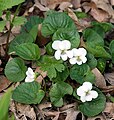Viola sororia
| Viola sororia | |
|---|---|

| |
| Scientific classification | |
| Kingdom: | Plantae |
| Clade: | Tracheophytes |
| Clade: | Angiosperms |
| Clade: | Eudicots |
| Clade: | Rosids |
| Order: | Malpighiales |
| Family: | Violaceae |
| Genus: | Viola |
| Species: | V. sororia
|
| Binomial name | |
| Viola sororia Willd.
| |
| Synonyms[1][2][3] | |
| |
Viola sororia, known commonly as the common blue violet, is a short-stemmed herbaceous perennial plant that is native to eastern North America. It is known by a number of common names, including common meadow violet, purple violet, woolly blue violet, hooded violet, and wood violet. Its cultivar 'Albiflora' has gained the Royal Horticultural Society's Award of Garden Merit.[4]
Self-seeding freely, in lawns and gardens it can be considered a weed by some. Cleistogamous seed heads may also appear on short stems in late summer and early autumn.
Taxonomy[]
Hairless common blue violets with purple flowers and bearded spurred petals have been variously called Viola sororia, V. affinis, and V. pratincola.[5][6] In the Chicago region, this hairless form is most frequently found in weedy areas such as old fields and lawns.[5] Hairy purple violets with blue flowers have been called "true" Viola sororia and are rarely seen outside of remnant wooded areas.[5]
A form with white flowers that have a purple center has been called Viola sororia fo. priceana (Confederate violet).
Viola sororia has several named hybrids:[3]
- Viola × bernardii (Viola pedaifida var. pedatifida × sororia)
- Viola × bissellii (Viola cucullata × sororia)
- Viola × cordifolia (Viola hirsutula × sororia)
- Viola × conjugens (Viola sagittata var. sagittata × sororia)
- Viola × insolita (Viola pedatifida var. brittoniana × sororia)
Uses[]
Beyond its use as a common lawn and garden plant, Viola sororia has historically been used for food and for medicine. The flowers and leaves are edible, and some sources suggest the roots can also be eaten. The Cherokee used it to treat colds and headaches. Rafinesque, in his Medical Flora, a Manual of the Medical Botany of the United States of North America (1828–1830), wrote of Viola sororia being used by his American contemporaries for coughs, sore throats, and constipation.
The leaves are high in vitamins A and C and can be eaten raw. The flowers have been made into jelly and candy.[7]
Ecology[]
The caterpillars of fritillary butterflies feed on these plants. The plants also serve as food for wild turkeys, rabbits, deer, livestock, the mourning dove, the bobwhite, and the white-footed mouse.[8]
Cultural significance[]
It is the state flower of Illinois, Rhode Island, New Jersey, and Wisconsin.[9]
Gallery[]

Flower

White flowering form

V. sororia 'Freckles'
References[]
- ^ "Viola sororia Willd.". Tropicos. Missouri Botanical Gardens – via The Plant List.
- ^ "Viola sororia var. missouriensis (Greene) L.E.McKinney". Tropicos. Missouri Botanical Gardens – via The Plant List.
- ^ Jump up to: a b Little, R. John; McKinney, Landon E. (2015). "Viola sororia". In Flora of North America Editorial Committee (ed.). Flora of North America North of Mexico (FNA). 6. New York and Oxford – via eFloras.org, Missouri Botanical Garden, St. Louis, MO & Harvard University Herbaria, Cambridge, MA.
- ^ "Viola sororia 'Albiflora' (Vt)". Royal Horticultural Society. Retrieved 25 August 2019.
- ^ Jump up to: a b c Wilhelm, Gerould; Rericha, Laura (2017). Flora of the Chicago Region: A Floristic and Ecological Synthesis. Indiana Academy of Sciences.
- ^ Reznicek, A. A.; Voss, E. G.; Walters, B. S., eds. (February 2011). "Viola". Michigan Flora Online. University of Michigan Herbarium. Retrieved 2018-08-20.
- ^ Niering, William A.; Olmstead, Nancy C. (1985) [1979]. The Audubon Society Field Guide to North American Wildflowers, Eastern Region. Knopf. p. 820. ISBN 0-394-50432-1.
- ^ Hilty, John (2016). "Common Blue Violet (Viola sororia sororia)". Illinois Wildflowers.
- ^ 2003-04 Wisconsin Statutes & Annotations: 1.10 State song, state ballad, state waltz, state dance, and state symbols.
Bibliography[]
- WFO (2019). "Viola L." World Flora Online. Retrieved 27 February 2020.
- POTWO. "Viola L." Plants of the World Online. Royal Botanic Gardens, Kew. Retrieved 6 March 2020.
- Connecticut Plants, Connecticut Botanical Society
- Viola sororia from the Virginia Tech Weed Identification Guide
- Duke, James. 1992. Handbook of Edible Weeds. CRC Press, Boca Raton, Florida.
- Viola sororia: University of Wisconsin-La Crosse
External links[]
| Wikimedia Commons has media related to Viola sororia. |
| Wikispecies has information related to Viola sororia. |
- Viola (plant)
- Symbols of Illinois
- Symbols of New Jersey
- Symbols of Rhode Island
- Symbols of Wisconsin
- Flora of North America
- Plants used in traditional Native American medicine



